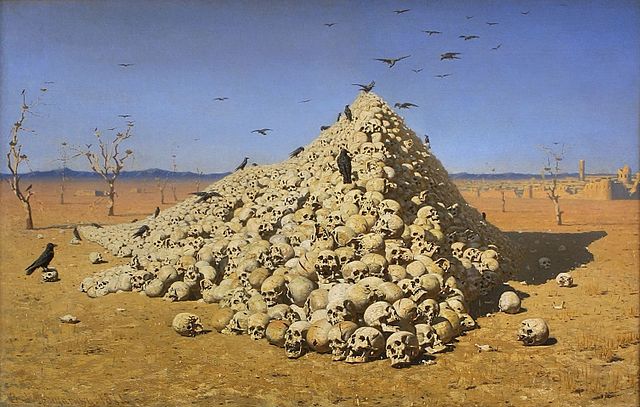The Resurgence of the Gospel, Part Three: The Challenge of the Muslim Curtain

Russian artist Vasily Vereshchagin painted “The Apotheosis of War” (1871) in part to reference to the Mongol conquests of Central Asia.
Image: Wikimedia Commons
Both Christians and Moslems fled into the mountains. Between 1318 and 1385, the churches Tithana, Jundishapur, Balada, Dasena, Karkha, Beth Bagas, Geslina, Baghdad, Mosul, Erbil, Nisibis, and eight others disappeared. Timur virtually stamped out Nestorian Christianity except for those who fled into the fastness of the Kurdistan mountains and in the heights of the Hakkiari mountains between Lakes Van and Urmia. Not until the 1550’s did they begin to emerge into history. Once numerous between Antioch and Chengchu, China, except for isolated moments between A.D 1246 and 1292 did the Nestorian Christians gain notice. In those two years a few travelers from Rome, and later from Venice, Italy broke through the Mongol Khanates before the rage and carnage of Timur lane.
The source for the ad 1246 visit was a letter to Pope Innocent IV written by Guyuk Khan of the Ulu Mongol tribe. It was written in the Persian language of the time and on the occasion of the arrival of Franciscan friars within his domain. The date at the end of the document corresponds to November ad 1246. Most likely it is in reference to the travels of William of Rubrick and John of Plano Carpini. In 1248, when back in Europe, John had written of his travels and whose return from the Mongol mission was recorded in the pages of Friar Salimbene of Parma who met him near Lyons. Both Carpini’s book of his travels and Salimbene’s report are in manuscript form and originally preserved in St. Mary’s Abbey at York, England.
This may not sound like a success story because it is the account of the failure of a mission to a landmass close to three times the length of the Mediterranean Sea and its coastal cities, from Caesarea in Palestine to Lusitania’s (Portugal) coast. However, when one takes into consideration the vast expanse of Asia, from Russia to Manchuria and China and the major cities in which Nestorian Christian bishoprics were found, it is more than remarkable how any semblance of Christianity survived, considering the carnage of Timur and his regime.
Two centuries later, about 1550, John Sulaka [also known as Simeon Sulacha and Mar Shimun VIII Yohannan Sulaqa] accompanied Franciscan missionaries all the way to Jerusalem where the Roman Catholic custodian of the Holy Sepulchre furnished him with introductory letters to Pope Julius III (1550). He was well received and through him, the process was begun to give the Nestorian Church a uniate status in which the Nestorians would retain their distinctive theology and liturgical practice in worship while having a fellowship with the Catholic Church.
Upon his return to Hurmizd, John Sulaka failed to win the whole community of Nestorian Christians to his side. He was also seized by the Turkish pasha of Diyar-Bekr and imprisoned where he was murdered. Where he failed to bring the Nestorian Christians into Uniate status with Rome, his successor, Ebedyeshu (1555-67), succeeded in doing so with recognition from Pope Pius IV (1559-1565). Over the next three centuries, three different Nestorian fellowships held uniate status with Rome.
Category: Church History, Winter 2019


